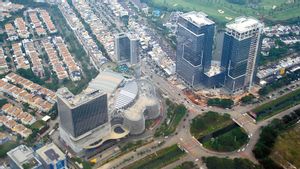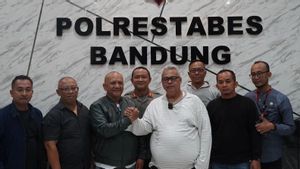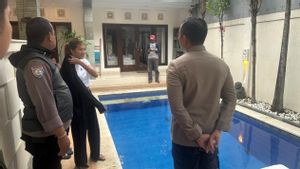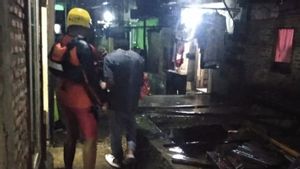JAKARTA - Jakarta has a large portion in the history of the presence of the Republic of Indonesia. This is because many historical events, ranging from colonial times to independence, took place in Jakarta. Because of its history, now there are 61 museums that can be visited by people from all over the country to get to know Indonesia, especially Jakarta more deeply.
Even so, learning history is sometimes not only done by visiting museums. This is because there is a lot of literacy that reveals that Jakarta is a collection of big villages that have become one. Therefore, one of the right options to learn about Jakarta is to visit its villages.
One of them is by visiting the village which is famous as Angke. As is known by residents of Jakarta, Kampung Angke is now an area of an Angke sub-district, which is included in the Tambora sub-district, West Jakarta.
Its location near the port of Sunda Kelapa makes this area have a very long history of civilization, even long before Jayakarta was controlled by the Dutch. Rachmat Ruchiat explained in the book The Origin of Place Names in Jakarta (2018), there are many assumptions about the origin of the name Angke.
"There is an opinion that the name Angke comes from the name of the first Jayakarta (Jakarta) ruler, Pangeran Tubagus Angke, Fattahilah's son-in-law. (However) the truth of this matter is still questionable. The reason is, in the Bujangga Manik manuscript it has been mentioned that one of the crew members came from the Angke area. "
Then, the manuscript which comes from Bujangga Manik's travel records, turns out to be proof that Angke's name has been around since the 15th century, and long before Prince Angke was in Jakarta. In that note, the owner of the article is told that he traveled from Pemalang to Kalapa (Sunda Kelapa) by boat.
"Nu badayung urang Tanjung, nu neem urang Kalapa, nu bobosek urang Angke." (The one who rowed the Tanjung, the one who drew the Kalapa, the one who paddled the Angke).
Interestingly, Angke's existence in history began to appear in 1618. Windoro Adi recorded this trace in the book Batavia 1740: Combing the Betawi Traces (2010). At that time, the reign of Prince Jayakarta made the Prince of Banten Ranamenggala secretly have the ambition to take over the area.
Despite having ambitions, Ranamenggala temporarily harbored those ambitions. On the orders of the Sultanate of Banten, he wanted to help Jayakarta troops in attacking the Dutch VOC trading partnership.
"On 22 December 1618, Ranamenggala deployed four thousand soldiers along the Angke river (Rivier van Angkee) to enter the Jayakarta Duchy. The Banten troops joined the Jayakarta Forces to attack the VOC. This is the first time blood has been shed in Kali Angke. "
Although only half-heartedly, Ranamenggala managed to repel the VOC and British troops. For his role in leading the troops of the Sultanate of Banten, the Governor-General of the VOC (1619-1623 and 1627-1629), Jan Pieterszoon Coen fled to Maluku to gather assistance in the context of a counterattack.
Angke is hauntedAlong the way, Angke's name became famous throughout the world because of the tragedy of the Chinese uprising in 1740. The tragedy that began with the defeat of the Dutch in competing with the British trading company, the East India Company (EIC), became the cause.
Followed by the Dutch mistake in the sugar export quota, the practice of selling residence permits, as well as rumors of Dutch atrocities against the ethnic Chinese who sparked the rebellion. As a result, the VOC guard posts and sugar factories were burned by the Chinese.
The extraordinary rebellion later in a few days turned into a bloody massacre of over ten thousand Chinese people. This bloody act that resembled genocide - ethnic cleansing - was later known as the "chinezenmoord" or the killing of Chinese people.
Furthermore, GB Schwarzen, in the book Reise in Oost-Indien (1751), wrote about his experience of being trapped in the "Geger Pacinan" incident which made Chinese people fearful because they were hunted down by the colonial government. Because, once a Chinese person was seen by VOC soldiers, no matter men, women or children, all of them were immediately killed.
"The sailors started breaking down the doors of the houses, then killed all the Chinese residents who were found and took everything they owned," wrote Scwarzen.
In line with Scwarzen, Adolf Heuken, in Historical Places in Jakarta (2007), revealed, on October 9, 1740, the search began. Suddenly, the house caught fire without knowing why. Then, things got out of hand again. People seemed to run into houses, stalls, Chinese shops and start robbing while killing mercilessly.
“The corpses lying in all corners of the city, both in the streets, rivers and canals, have turned the color of the water and land to red, including Kali Angke, which was in the vicinity of the settlements of ethnic Chinese residents. Kali Angke is full of corpses and tainted with fresh blood, ”said Hembing Wijayakusuma in the book Massacre 1740: Angke's Bloody Tragedy (2005).
On that basis, Kali Angke has become an icon that is closely related to the tragedy that is commonly referred to by local residents as the Angke Tragedy or Geger Pacinan. In fact, the war narrative against the ethnic Chinese then flared up throughout the island of Java.
"The term Kali Angke or Kali Merah is actually a bit confused, because in Chinese, ang means red and ke means kali. There are those who claim that the name Angke was obtained because the river water was contaminated with fresh blood so that it turned red, "Hembing concluded.
The English, Chinese, Japanese, Arabic, and French versions are automatically generated by the AI. So there may still be inaccuracies in translating, please always see Indonesian as our main language. (system supported by DigitalSiber.id)








